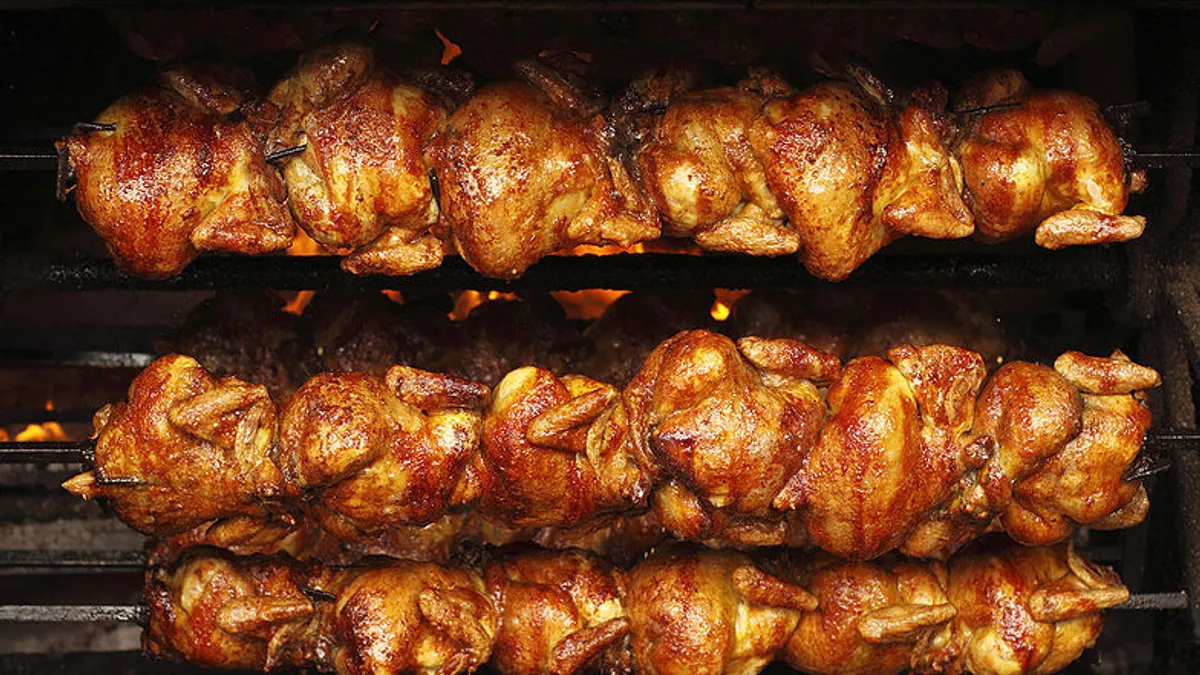Dive Brief:
- According to a CoBank report, Costco’s decision to bring their poultry production in-house represents the first time a retailer has assumed the risks associated with meat production.
- Costco’s rotisserie chickens are a major driver of customer traffic and sales have experienced 8% growth annually since 2010. Bringing production in-house is expected to save the company 10 to 35 cents per bird.
- “We see the decision by Costco to bring its poultry supply in-house as a result of three primary drivers — surety of supply, visibility up the chain and cost control,” Will Sawyer, lead animal protein economist at CoBank, said in the report. “The ability to control the consistency of bird weights enhances food preparation and safety.”
Dive Insight:
Although a nascent concept, the model of retailers vertically integrating into the food supply chain was set in motion when companies like Kroger, Walmart, Safeway and others began opening dairy facilities to produce their own fluid milk, ice cream and cheese.
Costco is the latest company looking to reap the many advantages of controlling its resources from farm to fork. In the case of both milk and chicken, fully integrating the supply chain allows retailers to position the products as "loss leaders" so they can sell products at below market cost to stimulate sales of other, more profitable, goods and services.
For Costco’s rotisserie chickens, this positioning will allow the retailer to keep their bottom line $4.99 pricing intact — a price that has not increased since 2009. The retailer has worked to maintain this rock-bottom price because its been such a draw for shoppers, and a boost for store loyalty. Last year the wholesaler sold about 87 million rotisserie chickens compared to about 60 million in 2013, Time magazine reported. In fact, Costco’s sales of the prepared poultry have experienced 8% growth annually since 2010, which is three times the growth rate of total poultry consumption in the U.S. There is even a Facebook page with over 10,000 followers dedicated to the retailer's beloved chicken, according to CoBank.
The Nebraska facility will be able to process 100 million birds per year and will provide one-third of the rotisserie chickens that Costco requires for its program. Whether Costco increases their production to supply all their rotisserie chicken needs will depend on if the margins associated with bringing production in-house outweigh the risks of food safety, potential negative profitability and supply chain exposure.
If in-house poultry production saves Costco a projected 35 cents per bird, that could yield about $35 million dollars annually — approximately the marginal loss that the company experiences for keeping their chickens at $4.99 a piece — Costco's chief financial officer, Richard Galanti, told The Seattle Times in 2015.
But chicken producers shouldn’t be worried yet. According to data from the National Chicken Council, per-capita chicken consumption in the U.S. has increased recently — Americans eat nearly twice as much chicken (92.2 pounds in 2017) as they do beef and pork (56.9 and 50 pounds in 2017, respectively.) Similarly, poultry sales are expected to remain strong at roughly $26.2 billion annually.
Still, suppliers should start paying attention. If Costco’s chicken production is successful, it will undoubtedly prompt questions across agricultural supply chains and lead other food retailers and foodservice companies to re-examine their business models.












